Analysis of Air Pollutants and Their Potential Sources in Eastern Xinjiang, Northwestern Inland China, from 2018 to 2022
Abstract
:1. Introduction
2. Materials and Methods
2.1. Study Area and Data Source
2.2. Source Analysis Models
3. Results
3.1. Air Quality and Main Pollutants
3.2. Temporal Variations of Air Pollutants
3.2.1. Interannual Changes
3.2.2. Diurnal, Weekly, and Monthly Variations
3.3. Regional Transport and Potential Contributing Sources
4. Conclusions
Supplementary Materials
Author Contributions
Funding
Institutional Review Board Statement
Informed Consent Statement
Data Availability Statement
Conflicts of Interest
References
- Hu, J.; Wang, Y.; Ying, Q.; Zhang, H. Spatial and temporal variability of PM2.5 and PM10 over the North China Plain and the Yangtze River Delta, China. Atmos. Environ. 2014, 95, 598–609. [Google Scholar] [CrossRef]
- Huang, R.J.; Zhang, Y.; Bozzetti, C.; Ho, K.F.; Cao, J.J.; Han, Y.; Daellenbach, K.R.; Slowik, J.G.; Platt, S.M.; Canonaco, F. High secondary aerosol contribution to particulate pollution during haze events in China. Nature 2014, 514, 218–222. [Google Scholar] [CrossRef] [PubMed]
- Li, Y.; Liu, X. How did urban polycentricity and dispersion affect economic productivity? A case study of 306 Chinese cities. Landsc. Urban Plan. 2018, 173, 51–59. [Google Scholar] [CrossRef]
- Polk, H. State of Global Air 2019: A Special Report on Global Exposure to Air Pollution and Its Disease Burden; Health Effects Institute: Boston, MA, USA, 2019. [Google Scholar]
- Wang, L.; Li, P.; Yu, S.; Mehmood, K.; Li, Z.; Chang, S.; Liu, W.; Rosenfeld, D.; Flagan, R.C.; Seinfeld, J.H. Predicted impact of thermal power generation emission control measures in the Beijing-Tianjin-Hebei region on air pollution over Beijing, China. Sci. Rep. 2018, 8, 934. [Google Scholar] [CrossRef] [PubMed]
- Shi, H.; Wang, Y.; Chen, J.; Huisingh, D. Preventing smog crises in China and globally. J. Clean. Prod. 2016, 112, 1261–1271. [Google Scholar] [CrossRef]
- Sheehan, P.; Cheng, E.; English, A.; Sun, F. China’s response to the air pollution shock. Nat. Clim. Change 2014, 4, 306–309. [Google Scholar] [CrossRef]
- Li, X.; Qiao, Y.; Shi, L. The aggregate effect of air pollution regulation on CO2 mitigation in China’s manufacturing industry: An econometric analysis. J. Clean. Prod. 2017, 142, 976–984. [Google Scholar] [CrossRef]
- Feng, Y.Y.; Ning, M.; Lei, Y.; Sun, Y.M.; Liu, W.; Wang, J.N. Defending blue sky in China: Effectiveness of the “Air Pollution Prevention and Control Action Plan” on air quality improvements from 2013 to 2017. J. Environ. Manag. 2019, 252, 109603. [Google Scholar] [CrossRef]
- Wang, J.; Lei, Y.; Ning, M. Chinese model for improving air quality: An assessment of action plan of air pollution prevention and control. Environ. Prot. 2018, 46, 7–11. [Google Scholar]
- Jiang, X.; Li, G.; Fu, W. Government environmental governance, structural adjustment and air quality: A quasi-natural experiment based on the Three-year Action Plan to Win the Blue Sky Defense War. J. Environ. Manag. 2021, 277, 111470. [Google Scholar] [CrossRef]
- Yang, J.; Ji, Z.; Kang, S.; Zhang, Q.; Chen, X.; Lee, S.-Y. Spatiotemporal variations of air pollutants in western China and their relationship to meteorological factors and emission sources. Environ. Pollut. 2019, 254, 112952. [Google Scholar] [CrossRef] [PubMed]
- Guo, P.; Umarova, A.B.; Luan, Y. The spatiotemporal characteristics of the air pollutants in China from 2015 to 2019. PLoS ONE 2020, 15, e0227469. [Google Scholar] [CrossRef] [PubMed]
- Yao, X.; Ge, B.; Li, A.; Chen, G.; Fan, F.; Xu, D.; Wang, Y.; Tang, X.; Kong, L.; Wang, Z. Spatio-temporal variation of PM2. 5 pollution in Xinjiang and its causes: The growing importance in air pollution situation in China. Front. Environ. Sci. 2023, 10, 1051610. [Google Scholar] [CrossRef]
- Zhou, W.; Chen, C.; Lei, L.; Fu, P.; Sun, Y. Temporal variations and spatial distributions of gaseous and particulate air pollutants and their health risks during 2015–2019 in China. Environ. Pollut. 2021, 272, 116031. [Google Scholar] [CrossRef]
- Qi, J.; Zheng, B.; Li, M.; Yu, F.; Chen, C.; Liu, F.; Zhou, X.; Yuan, J.; Zhang, Q.; He, K. A high-resolution air pollutants emission inventory in 2013 for the Beijing-Tianjin-Hebei region, China. Atmos. Environ. 2017, 170, 156–168. [Google Scholar] [CrossRef]
- Zhao, S.; Yu, Y.; Yin, D.; Qin, D.; He, J.; Dong, L. Spatial patterns and temporal variations of six criteria air pollutants during 2015 to 2017 in the city clusters of Sichuan Basin, China. Sci. Total Environ. 2018, 624, 540–557. [Google Scholar] [CrossRef]
- Dong, J.; Chen, X.; Cai, X.; Xu, Q.; Guan, Y.; Li, T.; Liu, S.; Chen, F. Analysis of the temporal and spatial variation of atmospheric quality from 2015 to 2019 based on China atmospheric environment monitoring station. J. Geo-Inf. Sci. 2020, 22, 1983–1995. [Google Scholar]
- Wang, Y.Q. MeteoInfo: GIS software for meteorological data visualization and analysis. Meteorol. Appl. 2014, 21, 360–368. [Google Scholar] [CrossRef]
- Wang, Y.Q. An Open Source Software Suite for Multi-Dimensional Meteorological Data Computation and Visualisation. J. Open Res. Softw. 2019, 7, 21. [Google Scholar] [CrossRef]
- Draxler, R.R.; Hess, G.D. An overview of the HYSPLIT_4 modelling system for trajectories. Aust. Meteorol. Mag. 1998, 47, 295–308. [Google Scholar]
- Wang, Y.; Stein, A.F.; Draxler, R.R.; de la Rosa, J.D.; Zhang, X. Global sand and dust storms in 2008: Observation and HYSPLIT model verification. Atmos. Environ. 2011, 45, 6368–6381. [Google Scholar] [CrossRef]
- Begum, B.A.; Kim, E.; Jeong, C.-H.; Lee, D.-W.; Hopke, P.K. Evaluation of the potential source contribution function using the 2002 Quebec forest fire episode. Atmos. Environ. 2005, 39, 3719–3724. [Google Scholar] [CrossRef]
- Wang, Y.; Zhang, X.; Arimoto, R. The contribution from distant dust sources to the atmospheric particulate matter loadings at XiAn, China during spring. Sci. Total Environ. 2006, 368, 875–883. [Google Scholar] [CrossRef] [PubMed]
- Polissar, A.; Hopke, P.; Paatero, P.; Kaufmann, Y.; Hall, D.; Bodhaine, B.; Dutton, E.; Harris, J. The aerosol at Barrow, Alaska: Long-term trends and source locations. Atmos. Environ. 1999, 33, 2441–2458. [Google Scholar] [CrossRef]
- Hsu, Y.-K.; Holsen, T.M.; Hopke, P.K. Comparison of hybrid receptor models to locate PCB sources in Chicago. Atmos. Environ. 2003, 37, 545–562. [Google Scholar] [CrossRef]
- Zhang, L.; Jin, L.; Zhao, T.; Yin, Y.; Zhu, B.; Shan, Y.; Guo, X.; Tan, C.; Gao, J.; Wang, H. Diurnal variation of surface ozone in mountainous areas: Case study of Mt. Huang, East China. Sci. Total Environ. 2015, 538, 583–590. [Google Scholar] [CrossRef] [PubMed]
- Yin, Z.; Cui, K.; Chen, S.; Zhao, Y.; Chao, H.-R.; Chang-Chien, G.-P. Characterization of the air quality index for Urumqi and Turfan cities, China. Aerosol Air Qual. Res. 2019, 19, 282–306. [Google Scholar] [CrossRef]
- Luo, Y.; Xu, L.; Li, Z.; Zhou, X.; Zhang, X.; Wang, F.; Peng, J.; Cao, C.; Chen, Z.; Yu, H. Air pollution in heavy industrial cities along the northern slope of the Tianshan Mountains, Xinjiang: Characteristics, meteorological influence, and sources. Environ. Sci. Pollut. Res. Int. 2023, 30, 55092–55111. [Google Scholar] [CrossRef]
- Turap, Y.; Rekefu, S.; Wang, G.; Talifu, D.; Gao, B.; Aierken, T.; Hao, S.; Wang, X.; Tursun, Y.; Maihemuti, M. Chemical characteristics and source apportionment of PM2. 5 during winter in the southern part of Urumqi, China. Aerosol Air Qual. Res. 2019, 19, 1325–1337. [Google Scholar] [CrossRef]
- Xu, G.; Jiao, L.; Zhang, B.; Zhao, S.; Yuan, M.; Gu, Y.; Liu, J.; Tang, X. Spatial and temporal variability of the PM2. 5/PM10 ratio in Wuhan, Central China. Aerosol Air Qual. Res. 2017, 17, 741–751. [Google Scholar] [CrossRef]
- Song, C.; Wu, L.; Xie, Y.; He, J.; Chen, X.; Wang, T.; Lin, Y.; Jin, T.; Wang, A.; Liu, Y. Air pollution in China: Status and spatiotemporal variations. Environ. Pollut. 2017, 227, 334–347. [Google Scholar] [CrossRef] [PubMed]
- Filonchyk, M. Characteristics of the severe March 2021 Gobi Desert dust storm and its impact on air pollution in China. Chemosphere 2022, 287, 132219. [Google Scholar] [CrossRef] [PubMed]
- Yang, J.; Fu, X.; Qiao, L.; Yao, L.; Zhang, F.; Li, W. Characteristics of Atmospheric Pollution in a Chinese Megacity: Insights from Three Different Functional Areas. Sustainability 2023, 15, 2429. [Google Scholar] [CrossRef]
- Wang, N.; Zhu, C.; Li, W.; Qiu, M.; Wang, B.; Li, X.; Jiang, B.; Qu, X.; Li, Z.; Cheng, H. Air quality improvement assessment and exposure risk of Shandong Province in China during 2014 to 2020. Int. J. Environ. Sci. Technol. 2022, 20, 9495–9504. [Google Scholar] [CrossRef] [PubMed]
- Li, J. Characteristics, Source, Long-Range Transport of Dust Aerosol Over the Central Asia and Its Potential Effect on Global Change; Fudan Universtiy: Shanghai, China, 2009. [Google Scholar]
- Xuan, J. Dust emission factors for environment of Northern China. Atmos. Environ. 1999, 33, 1767–1776. [Google Scholar] [CrossRef]
- Zhang, X.-X.; Sharratt, B.; Chen, X.; Wang, Z.-F.; Liu, L.-Y.; Guo, Y.-H.; Li, J.; Chen, H.-S.; Yang, W.-Y. Dust deposition and ambient PM 10 concentration in northwest China: Spatial and temporal variability. Atmos. Chem. Phys. 2017, 17, 1699–1711. [Google Scholar] [CrossRef]
- Wang, Y.; Tang, J.; Zhang, Z.; Wang, W.; Wang, J.; Wang, Z. Hybrid Methods’ Integration for Remote Sensing Monitoring and Process Analysis of Dust Storm Based on Multi-Source Data. Atmosphere 2022, 14, 3. [Google Scholar] [CrossRef]
- Wang, P.; Chen, K.; Zhu, S.; Wang, P.; Zhang, H. Severe air pollution events not avoided by reduced anthropogenic activities during COVID-19 outbreak. Resour. Conserv. Recycl. 2020, 158, 104814. [Google Scholar] [CrossRef]
- Zhai, H.; Yao, J.; Wang, G.; Tang, X. Spatio-Temporal Characteristics and Variation Pattern of the Atmospheric Particulate Matter Concentration: A Case Study of the Beijing–Tianjin–Hebei Region, China. Atmosphere 2022, 13, 120. [Google Scholar] [CrossRef]
- Javed, Z.; Bilal, M.; Qiu, Z.; Li, G.; Sandhu, O.; Mehmood, K.; Wang, Y.; Ali, M.A.; Liu, C.; Wang, Y. Spatiotemporal characterization of aerosols and trace gases over the Yangtze River Delta region, China: Impact of trans-boundary pollution and meteorology. Environ. Sci. Eur. 2022, 34, 86. [Google Scholar] [CrossRef]
- Blanco-Becerra, L.C.; Gáfaro-Rojas, A.I.; Rojas-Roa, N.Y. Influence of precipitation scavenging on the PM2.5PM10 ratio at the Kennedy locality of Bogotá, Colombia. Rev. Fac. Ing. Univ. De Antioq. 2015, 76, 58–68. [Google Scholar] [CrossRef]
- Bai, Y.; Wang, Z.; Xie, F.; Cen, L.; Xie, Z.; Zhou, X.; He, J.; Lü, C. Changes in stoichiometric characteristics of ambient air pollutants pre-to post-COVID-19 in China. Environ. Res. 2022, 209, 112806. [Google Scholar] [CrossRef] [PubMed]
- Nirel, R.; Dayan, U. On the Ratio of Sulfur Dioxide to Nitrogen Oxides as an Indicator of Air Pollution Sources. J. Appl. Meteorol. 2001, 40, 1209–1222. [Google Scholar] [CrossRef]
- Aneja, V.P.; Agarwal, A.; Roelle, P.A.; Phillips, S.B.; Tong, Q.; Watkins, N.; Yablonsky, R. Measurements and analysis of criteria pollutants in New Delhi, India. Environ. Int. 2001, 27, 35–42. [Google Scholar] [CrossRef] [PubMed]
- Qian, Z.; Meng, Q.; Chen, K.; Zhang, Z.; Liang, H.; Yang, H.; Huang, X.; Zhong, W.; Zhang, Y.; Wei, Z. Machine Learning Explains Long-Term Trend and Health Risk of Air Pollution during 2015–2022 in a Coastal City in Eastern China. Toxics 2023, 11, 481. [Google Scholar] [CrossRef]
- Li, S.; Li, X.; Deng, Z.; Xia, X.; Ren, G.; An, D.; Ayikan, M.; Zhong, Y. Characteristics of atmospheric boundary layer and its relation with PM2. 5 during winter in Shihezi, an Oasis city in Northwest China. Atmos. Pollut. Res. 2023, 14, 101902. [Google Scholar] [CrossRef]
- Wang, Y.; Gao, J.; Mamtimin, A.; Sayit, H.; Zhou, C.; Li, R.; Dawut, M.; Yang, F.; Huo, W.; Wen, C. Evolution law of atmospheric boundary layer in Gurbantünggüt Desert based on reanalysis dataset and in situ observation data. Heliyon 2023, 9, e14147. [Google Scholar] [CrossRef]
- Li, H.; Zhou, D.; Wei, Y. An Assessment of PM2.5-Related Health Risks and Associated Economic Losses in Chinese Cities. Huan Jing Ke Xue Huanjing Kexue 2018, 39, 3467–3475. [Google Scholar] [CrossRef]
- Liu, Y.; Zhou, Y.; Lu, J. Exploring the relationship between air pollution and meteorological conditions in China under environmental governance. Sci. Rep. 2020, 10, 14518. [Google Scholar] [CrossRef]
- Fang, C.; Li, Z.; Shi, W.; Wang, J. Analysis of Pollution Characteristics and Emissions Reduction Measures in the Main Cotton Area of Xinjiang. J. Environ. Res. Public Health 2023, 20, 2273. [Google Scholar] [CrossRef]
- Van Hooijdonk, I.G.S.; Clercx, H.J.H.; Abraham, C.; Holdsworth, A.M.; Monahan, A.H.; Vignon, E.; Moene, A.F.; Baas, P.; van de Wiel, B.J.H. Near-surface temperature inversion growth rate during the onset of the stable boundary layer. J. Atmos. Sci. 2017, 74, 3433–3449. [Google Scholar] [CrossRef]
- Yin, X.; Kang, S.; de Foy, B.; Ma, Y.; Tong, Y.; Zhang, W.; Wang, X.; Zhang, G.; Zhang, Q. Multi-year monitoring of atmospheric total gaseous mercury at a remote high-altitude site (Nam Co, 4730 m asl) in the inland Tibetan Plateau region. Atmos. Chem. Phys. 2018, 18, 10557–10574. [Google Scholar] [CrossRef]
- Lu, Z.; Streets, D.G.; Zhang, Q.; Wang, S. A novel back-trajectory analysis of the origin of black carbon transported to the Himalayas and Tibetan Plateau during 1996–2010. Geophys. Res. Lett. 2012, 39, 1–6. [Google Scholar] [CrossRef]
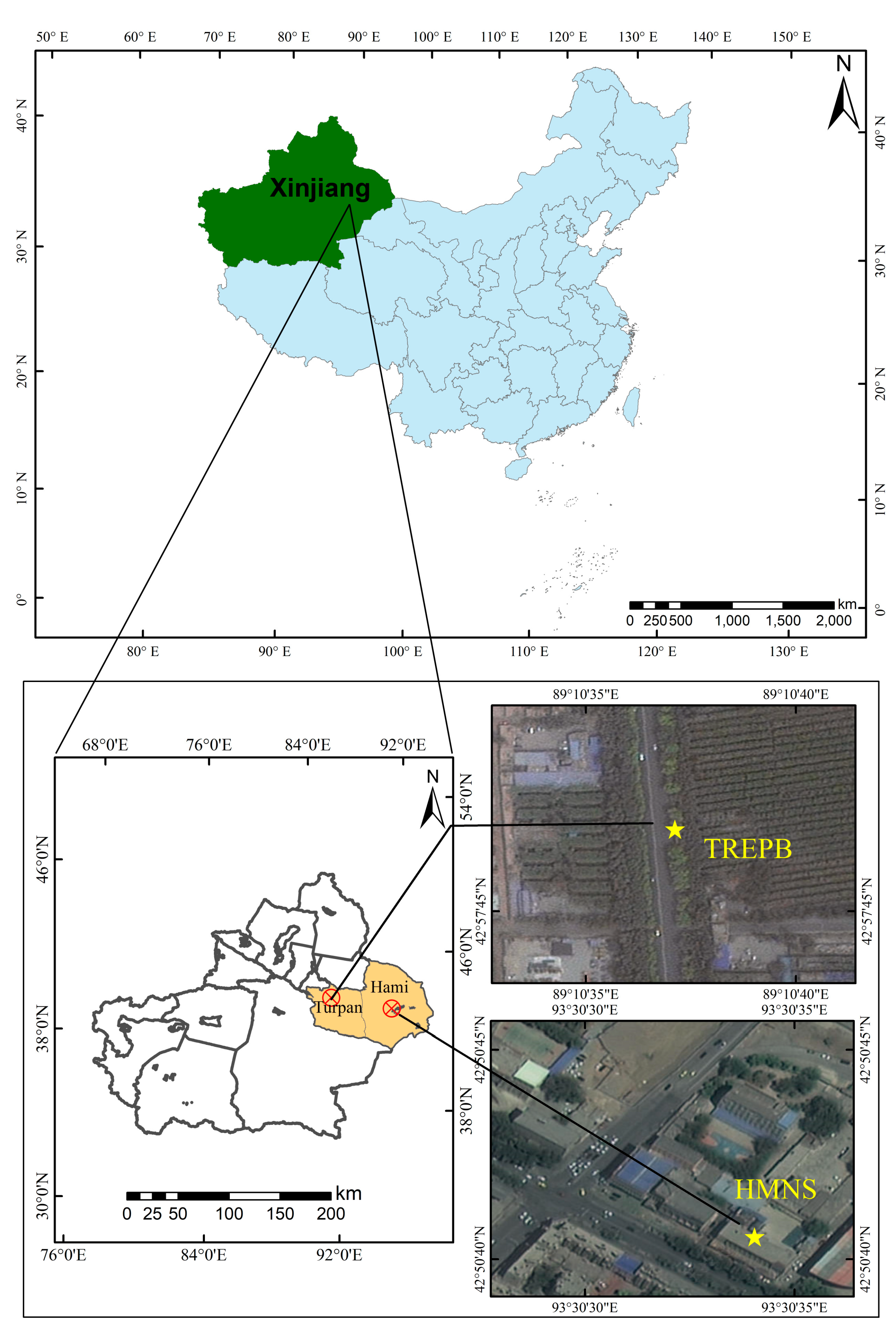
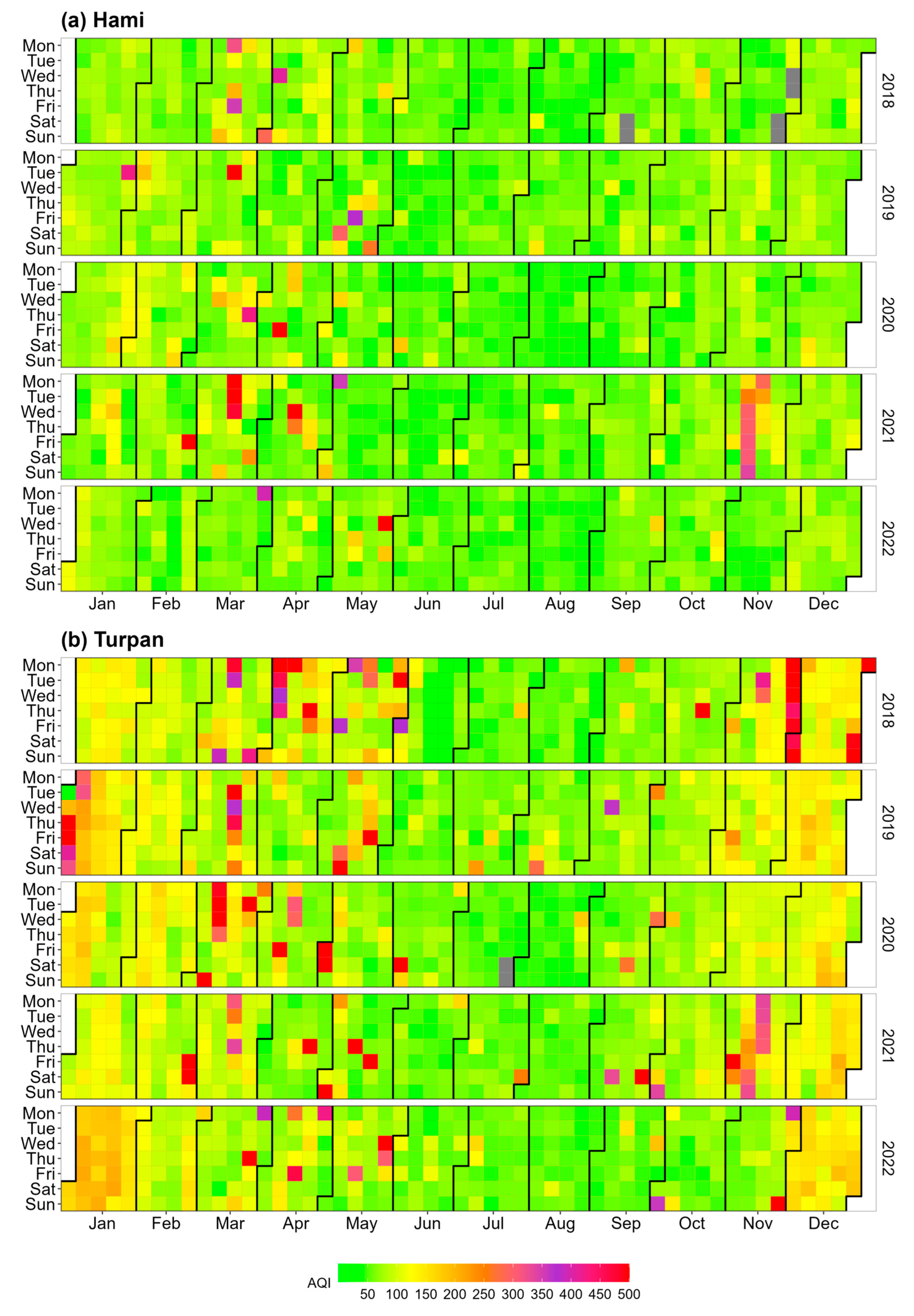
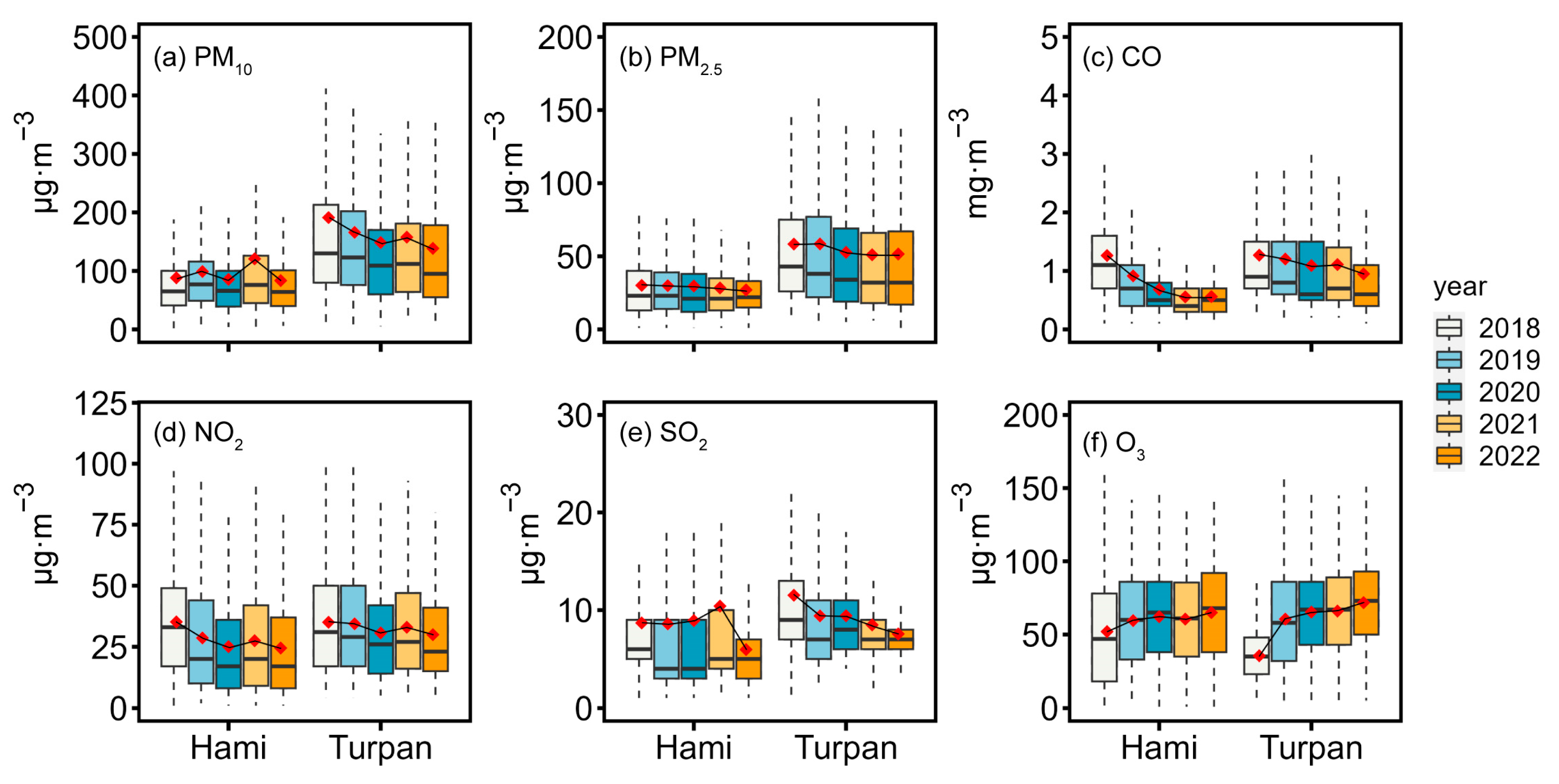
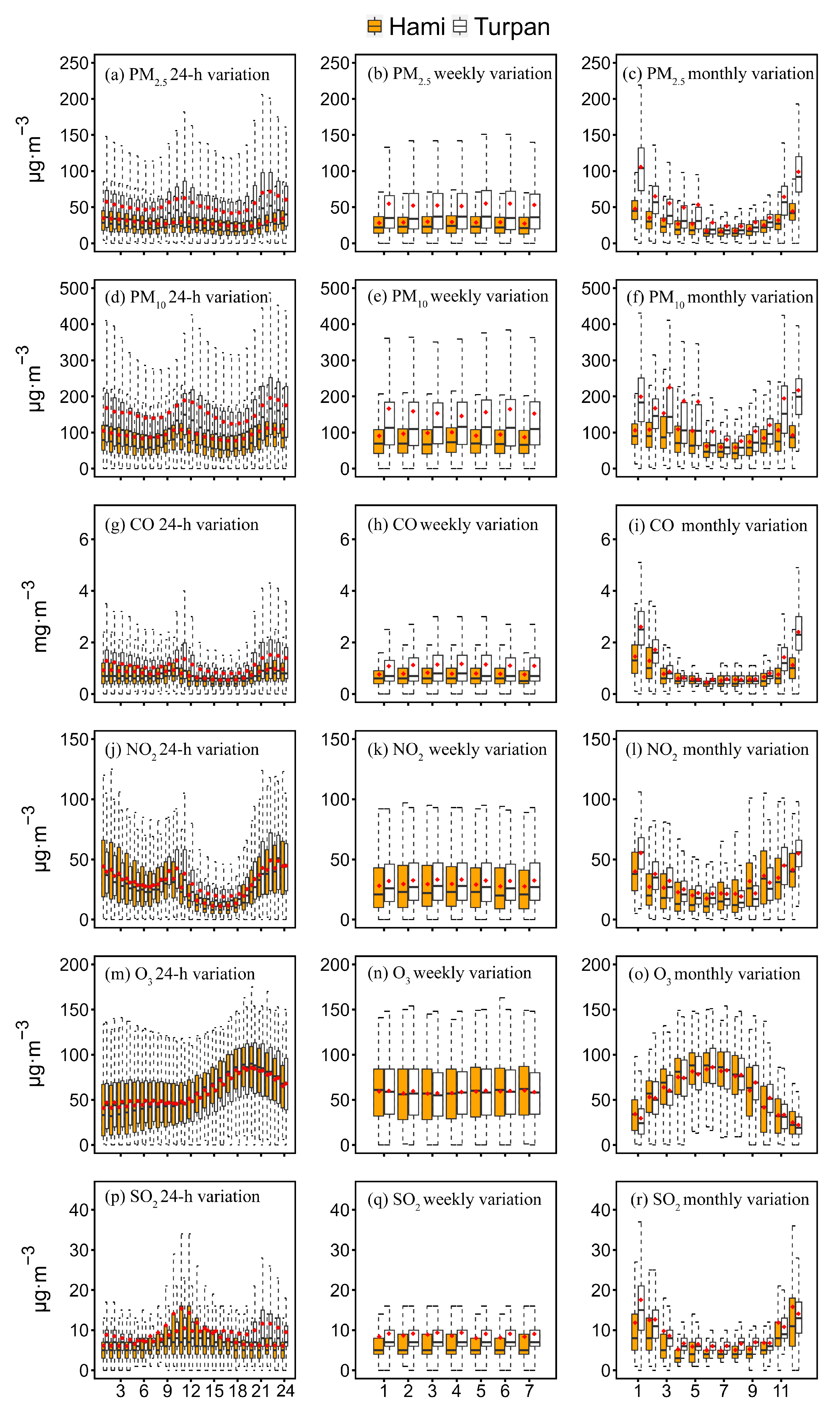
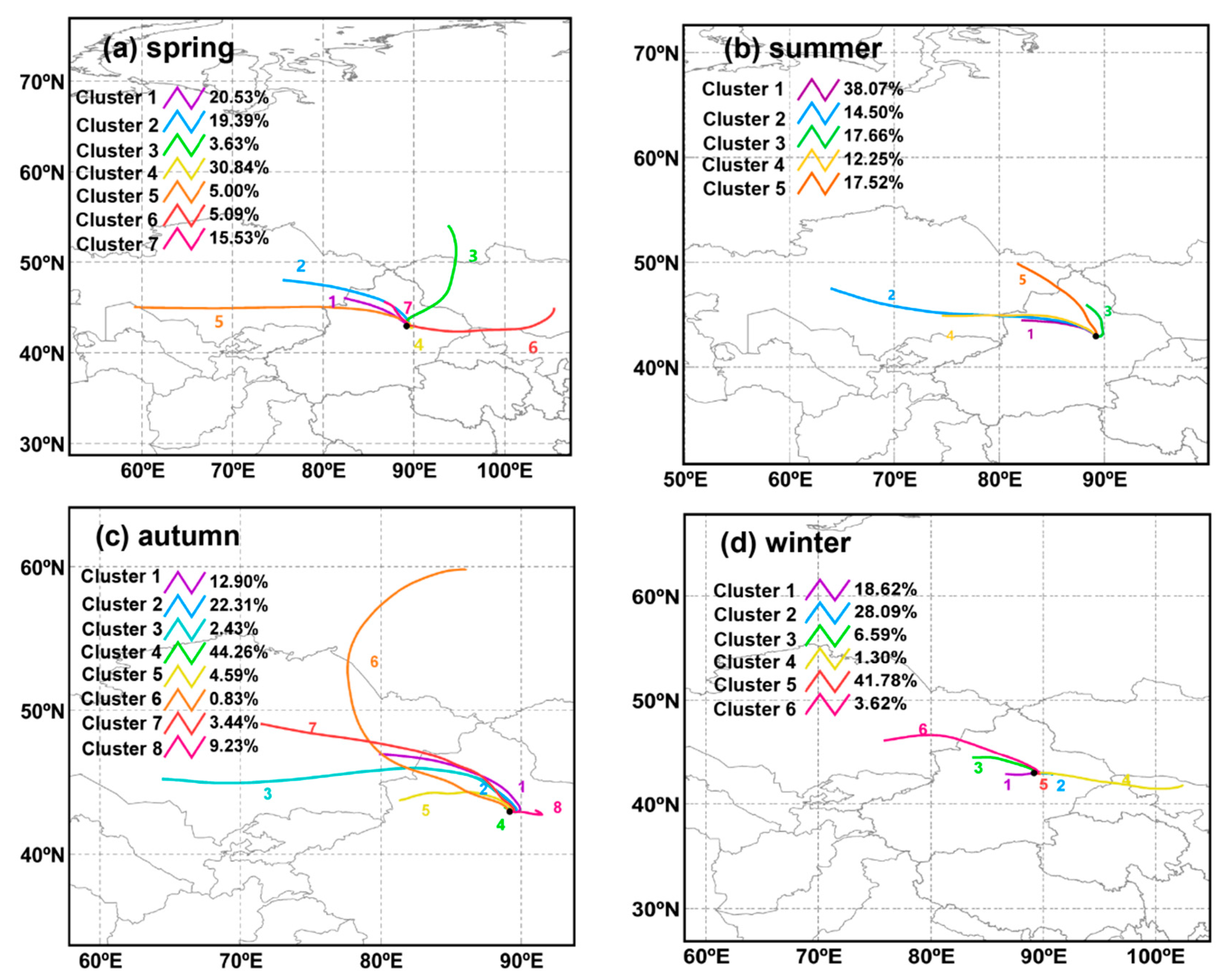
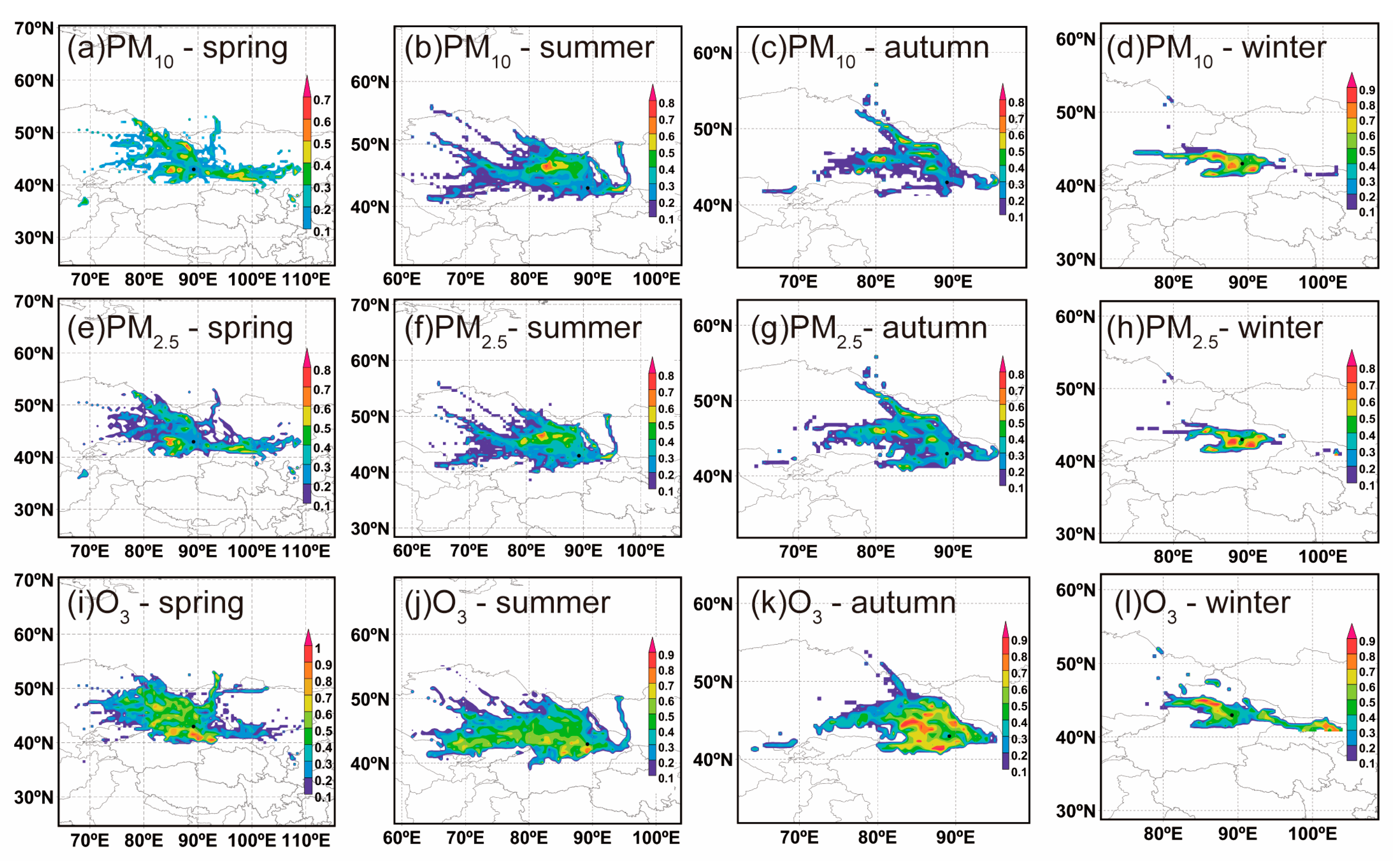
| Site | Year | PM2.5 | PM10 | CO | NO2 | O3-8h | SO2 |
|---|---|---|---|---|---|---|---|
| 2018 | 9.75% | 43.7% | 1.39% | 16.4% | 5.85% | 0.00% | |
| 2019 | 6.85% | 72.9% | 0.27% | 0.82% | 0.82% | 0.00% | |
| Hami | 2020 | 12.6% | 56.8% | 0.00% | 1.37% | 0.55% | 0.00% |
| 2021 | 0.00% | 70.4% | 0.27% | 0.82% | 0.82% | 0.00% | |
| 2022 | 0.55% | 68.5% | 0.00% | 0.82% | 3.56% | 0.00% | |
| Total | 5.93% | 62.5% | 0.38% | 4.01% | 2.31% | 0.00% | |
| 2018 | 11.5% | 78.4% | 0.00% | 0.00% | 0.00% | 0.00% | |
| 2019 | 15.1% | 78.4% | 0.00% | 0.00% | 1.64% | 0.00% | |
| Turpan | 2020 | 17.6% | 69.2% | 0.00% | 0.00% | 1.65% | 0.00% |
| 2021 | 12.1% | 77.3% | 0.00% | 0.00% | 1.10% | 0.00% | |
| 2022 | 15.3% | 67.1% | 0.00% | 0.00% | 4.66% | 0.00% | |
| Total | 14.3% | 74.1% | 0.00% | 0.00% | 1.81% | 0.00% |
Disclaimer/Publisher’s Note: The statements, opinions and data contained in all publications are solely those of the individual author(s) and contributor(s) and not of MDPI and/or the editor(s). MDPI and/or the editor(s) disclaim responsibility for any injury to people or property resulting from any ideas, methods, instructions or products referred to in the content. |
© 2023 by the authors. Licensee MDPI, Basel, Switzerland. This article is an open access article distributed under the terms and conditions of the Creative Commons Attribution (CC BY) license (https://creativecommons.org/licenses/by/4.0/).
Share and Cite
Zhang, Y.; Xu, H.; Zhang, Y.; Luo, J.; Chen, F.; Cao, B.; Xie, M. Analysis of Air Pollutants and Their Potential Sources in Eastern Xinjiang, Northwestern Inland China, from 2018 to 2022. Atmosphere 2023, 14, 1670. https://doi.org/10.3390/atmos14111670
Zhang Y, Xu H, Zhang Y, Luo J, Chen F, Cao B, Xie M. Analysis of Air Pollutants and Their Potential Sources in Eastern Xinjiang, Northwestern Inland China, from 2018 to 2022. Atmosphere. 2023; 14(11):1670. https://doi.org/10.3390/atmos14111670
Chicago/Turabian StyleZhang, Yuanyuan, Hui Xu, Yunhui Zhang, Jie Luo, Fuyao Chen, Bo Cao, and Mingjie Xie. 2023. "Analysis of Air Pollutants and Their Potential Sources in Eastern Xinjiang, Northwestern Inland China, from 2018 to 2022" Atmosphere 14, no. 11: 1670. https://doi.org/10.3390/atmos14111670
APA StyleZhang, Y., Xu, H., Zhang, Y., Luo, J., Chen, F., Cao, B., & Xie, M. (2023). Analysis of Air Pollutants and Their Potential Sources in Eastern Xinjiang, Northwestern Inland China, from 2018 to 2022. Atmosphere, 14(11), 1670. https://doi.org/10.3390/atmos14111670





